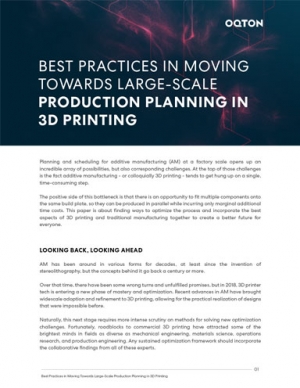Securing Design IP in Distributed Manufacturing
Decentralized production models increase security and risk exposure of standard design intellectual property and additive manufacturing process parameters and recipes.

Fieldmade’s NOMAD 03 (PBF-LB/M) mobile, distributed AM microfactory operates above the Arctic Circle in northern Norway. Image courtesy of Fieldmade.
Latest News
April 22, 2024
In a fast-changing world, companies are turning to distributed and on-demand manufacturing to achieve greater flexibility and higher resiliency. Yet the shift to new production models raises a host of security and intellectual property (IP) concerns, especially as additive manufacturing (AM) enters the mix.
Distributed and more localized manufacturing models are gaining traction in response to various events, including ongoing supply chain disruptions in wake of the pandemic, rising geopolitical conflicts and catastrophic weather cycles. While a decentralized manufacturing approach is a workaround for many of these challenges, it’s not a cost-effective solution for goods that require labor- or equipment-intensive manufacturing.
On the other hand, for low-volume, highly complex parts like those common in aerospace and military use cases, distributed AM offers better economics compared to conventional production methods while situating production closer to localized demand. The model also holds promise for producing spare parts on demand, eliminating the need for maintaining redundant inventories around the globe.
“The distributed manufacturing model makes the whole supply chain more resilient for parts,” says Henrike Wonneberger, co-founder and chief operating officer at Replique, a maker of a secure, cloud-based 3D printing platform that empowers businesses to produce high-quality parts on demand across global locations.
“For many decades, it worked well to plan manufacturing when the supply chain was stable and well balanced,” Wonneberger says. “With so many things now happening, companies need the ability to shift and adapt. Distributed manufacturing is a flexible model that offers a sense of resiliency, keeps lead times short and ensures availability.”
AM’s highly integrated digital backbone makes it a natural choice for supporting decentralized production. However, despite the advantages, an AM-enabled distributed manufacturing model exposes companies to heightened security risks for standard design IP and the process parameters and unique recipes that are central to repeatable and consistent AM output of high-quality parts in any location.
“Distributed manufacturing has huge potential for cost improvements, increased part performance and customer satisfaction, but the nature of moving IP outside a company’s four walls opens up more opportunity for vulnerabilities,” says Tripp Burd, director of new platforms at Markforged.

With distributed manufacturing based on AM, companies must be vigilant about ensuring design IP doesn’t end up in the wrong hands. At the same time, they also need to create parts they can stand behind and maintain.
“It’s not just about IP being stolen or products being reverse engineered,” Burd says. “Imagine if parts reach customers that don’t meet quality requirements. That could hurt a company’s reputation.”
AM’s Unique IP Challenges
Protecting design IP is always a top priority with any production method. But beyond the traditional worries about stolen product designs or reverse engineering of critical parts, AM, and particularly use of AM for distributed manufacturing, raises the stakes with a variety of unique challenges.
There are three facets to securing design IP in a distributed AM environment, according to Bryan Crutchfield, vice president and general manager at Materialise. These are:
1. Digital rights management, or the ability to protect designs and set restrictions on the number of printed parts.
2. Securing proprietary data related to the product, including customer data that could be governed by privacy laws.
3. Protecting the specific AM recipe, encompassing the materials makeup along with print and build parameters and specifications.
Materialise’s Identify3D technology covers many of those bases for distributed manufacturing, providing IP protection while ensuring manufacturing repeatability and traceability, from the initial design through to the finished product. The Identify3D suite encrypts data at rest and protects design IP all the way through to the 3D printer while also enforcing business and production rules, including restrictions on the number of prints allowed as well as locking in specific machine parameters.
The software is available as a standalone application, and Materialise is working to integrate into its CO-AM platform and make it available through partnerships with printer original equipment manufacturers (OEMs), Crutchfield says.
Typically, the IP conversation is centered on the need to protect designs and manufacturing processes, but it shouldn’t end there. A distributed AM scenario should also account for liability and regulation.
For example, if an OEM makes a design for a critical replacement part and transfers the digital asset to a third party for 3D printing, everything might visibly appear to be within spec, but if months later, the component fails, it’s not just a cost issue related to replacing defective parts. Rather, the greater risk is possible damage to a customer’s critical systems.

“People worry about digital rights management and they worry about designs, but they forget about liability, which can be much more costly,” says Roy Sterenthal, vice president of software at Oqton, which provides a software platform to support industrial-grade AM.
Oqton’s platform integrates with digital rights management solutions and supports the encryption and decryption capabilities delivered by 3D printer OEMs to ensure design IP is adequately protected, Sterenthal says.
In-situ monitoring capabilities, which create log files of activities that transpire during an AM build, can be another asset for avoiding liability. In-situ monitoring capabilities provide a step-by-step audit trail of how a part was created as well as memorializing the path from production to customer delivery.
“What you’re looking for is the ability to get all relevant information, whether in real time or after the fact,” he says. “You need to know everything from the exact materials specifications to the build temperature at a specific point to the formal workflow. In that way, when a part is delivered to the end customer, there is an entire collection of data reflecting how it was manufactured.”
IP and Security Best Practices
When it comes to legal protections surrounding design IP, the considerations aren’t any different with AM than with other conventional manufacturing methods.
“It comes down to basic IP considerations: do I want to keep everything protected through trade secrets or through patents?” asks Michael Baniak, EOS general counsel (US) and chief IP counsel.
Companies need to consider the costs associated with patents, and with distributed manufacturing, it’s advisable to take a global view, pursuing patents only in key markets.
Following proven IT cybersecurity best practices is another requisite for protecting design IP in a distributed AM manufacturing model. Embracing manufacturing partners committed to key practices such as Zero Trust, role-based access controls, encryption, automated penetration testing on cloud platforms and 3D printers, third-party audits and single sign-on infrastructure ensure only the right people have access to design and AM process data, says Doug Kenik, lead of the software product management team at Markforged.

Markforged Digital Source ensures flexibility for printing parts without compromising IP security or reverse engineering of designs. Click here for full-size image. Image courtesy of Markforged.
To that point, Markforged supports many of those best practices in its industrial AM printer line and Eiger cloud-based AM software while taking things a step further as reportedly claiming to be the first AM company to receive ISO/IEC 27001 certification, an international standard governing how organizations manage information security.
Moreover, the company’s latest Digital Source business-to-business platform ensures the exchange of secure IP in a distributed AM model.
“Digital Source gets the right part to an extended network without compromising IP—it takes the security stance and principles of a 3D printing ecosystem and extends it across the full supply chain,” Kenik says.
Aligning with like-minded partners—for example, 3D printer manufacturers committed to end-to-end encryption capabilities or integrators and software providers that embrace principles like Zero Trust and audits—will ensure design IP is adequately safeguarded in a distributed AM environment, says Omar Fergani, CEO at 1000 Kelvin, whose flagship product AMAIZE is billed as an artificial intelligence (AI) co-pilot for AM helping to predict near real-time print issues to optimize print runs.
“Working with like-minded partners like AWS and EOS who share the value of security make things go faster and easier,” Fergani says.
Taking steps to secure and enforce AM process parameters is another important aspect of IP protection in a distributed manufacturing scenario. Appliance manufacturer Miele has made that a top priority with its 3D4U brand program, which serves up innovative 3D printed accessories that are produced just in time and shipped directly to customers.
The designs—a coffee clip, borehole cleaner and valuable separator vacuum cleaner attachments—are stored, managed and securely sent to suppliers via Replique’s digital inventory platform. The Replique platform ensures qualified processes for serial AM production, including technology, material and print parameter optimization, are repeatable across the distributed AM network and that the final output meets Miele’s quality requirements.
“Miele has to trust their standard of quality is always there through the process even though they never see these parts,” Wonneberger says.
While technology advances and process improvements have addressed some of the design IP issues and plugged some security gaps with distributed AM, there is still a lot more work to be done, according to Nils Knofius, head of digitalization at Fieldmade AS, an integrator specializing in building digital parts inventories and mobile AM units, to print parts at point of need.
With a focus on the defense, logistics and shipping industries, Knofius says the design IP security conundrum still mostly comes down to developing trust and relationship building, which is simply not enough as organizations adopt distributed manufacturing.
“You can establish a good relationship with a contract manufacturer so you know they won’t share designs, but as things get more distributed, it is more challenging to rely on that,” Knofius says. The current landscape is limited in that there are end-to-end solutions that guarantee full traceability and security to the IP owner, but they are controlled by one technology provider, which has various drawbacks in terms of competition, customization and know-how exploitation, he says.
“Ultimately, we should end up with ecosystems in which any actor can participate if they fulfill the ecosystem and/or stakeholder requirements,” Knofius says. “It’s something we all aspire to.”
More EOS Coverage
More Markforged Coverage
More Materialise Coverage
More Oqton Coverage

Subscribe to our FREE magazine, FREE email newsletters or both!
Latest News
About the Author
Beth Stackpole is a contributing editor to Digital Engineering. Send e-mail about this article to [email protected].
Follow DE






